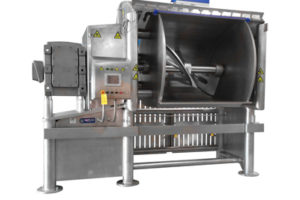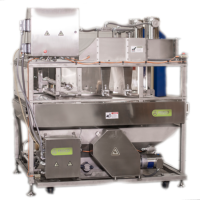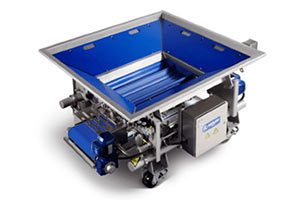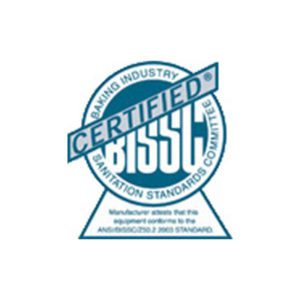Mixers
How can I prevent premature damage to my agitator shaft?
Our standard shaft utilizes a lip seal which rides on the shaft as it rotates. Regular shaft seal cleaning and lubrication help prevent leakage and damage to the agitator shaft at the sealing area.
Optional rotary seals are available for all mixers that rotate with the shaft, removing potential wear points at seal contact areas. They also provide superior sealing with less maintenance.
What can cause excessive wear to the drive sprockets?
Drive chain tension that is too loose or too tight will cause excessive wear to the sprockets and chain. Keep the chain properly lubricated. Drive chains on new production mixers are very uncommon; modern mixers utilize Poly Chain drive belts or are directly driven from gear motors.
What affects the cooling of my product?
Cooling requirements have many variables. The mixing bowl, depending on its design, can only transfer a certain amount of heat from the dough. The largest producer of heat is the main drive motor. The removal of heat from the dough is based on the amount of time the dough is in contact with the cooled surfaces of the mixing bowl. Therefore, the faster the mix time, the less heat is removed.
What can deteriorate the lubrication on my mixer?
Power spraying (wash down) of a mixer can remove required lubrication from areas of the mixer where it is required. You can also force water intended for cleaning beyond seals and into bearings. Cleansing foams and disinfectants can also break down or remove lubrication. It is always a good practice to time lubrication cycles after a washdown is completed.
When should I replace the roller bar and breaker bar bushings?
A routine check of the bushings used on high-speed mixers is recommended during each sanitation cycle. The roller bar bushings should be replaced if the roller bars have 1/8″ up and down movement inside the bushing. A clanking noise when jogging an empty mixer is a good indication that the bushings need to be replaced. Bushings are considered a wear item and may need to be replaced annually depending on usage.
Should I inspect the canopy scraper on my mixer?
If the mixer is equipped with a canopy scraper, check it weekly for wear or damage. A properly adjusted scraper will contact and clean the underside of the canopy as the bowl is tilted down.
When should I inspect the flour gate valve?
Inspect the flour gate valve for proper operation weekly. Old dough can build up on the moving parts of the gate and cause it to malfunction.
Should I inspect the mixer drive motor and reducer?
Inspect the drive motor and reducer for changes in noise level. Check the oil in the reducer. Change the oil in the reducer yearly. Lubricate the motor every 6 months. Follow the instructions in the machinery manual and use the proper type of grease in the motor.
How should I inspect the cooling hoses on my mixer?
Check the condition of the cooling hoses for cracks and frayed spots. Observe hoses as the bowl is tilting up and down to confirm free travel and ensure hoses are not kinking. Replace the hoses yearly to prevent hose breakage and loss of coolants.
How do I inspect gears on double sigma arm mixers?
Double arm mixers have a gear case mounted on the mixing bowl that transfers the power from the input shaft to the agitators. Inspect the gear case for oil leakage. Feel the bearing housings mounted on the sides of the gear case for excessive heating. Inspect oil level and condition monthly, changing the oil as recommended in the manual. Backlash or wear in gears can be determined by manually rotating an agitator arm independently of other agitators, noting free play.
How can I minimize danger to people operating the mixer?
Training. Training. Training. Review your manual and make sure the operator understands how to operate your equipment safely. Here are a few tips:
- Require mandatory reading of the manual.
- Prior to allowing operation, ensure proper training has been provided to all operators/maintenance/sanitation staff.
- Provide and give refresher training as needed considering turnover of personnel, process adjustments and equipment modifications.
- Test the limit and safety switch operation and adjustment.
- Test the push button safety circuit EVERY SHIFT.
- Establish and follow a Lockout / Tagout (LOTO) program for all production machinery in your facility.
What is the mixing capacity of my mixer?
Mixing capacity for a given size of mixer will vary with the type of dough, its moisture content and density of the dough. There is a maximum as well as a minimum batch size for each mixer.
When should I tighten/torque the bolts in my high-speed mixer?
This would include agitator hub and roller bar cap bolts, motor and reducer mounting bolts, coupling bolts, bowl mounting bolts, and sprocket and pulley bolts. This should be done before start up, after the first shift of production and then following maintenance intervals as listed in manuals. Torque specifications are in the operation manual.
Are there cleaning guidelines for my mixer?
KleanVue and Traditional frame mixers will have different approaches and cleaning requirements due to their construction. Pressure cleaning the inside of the mixing bowl, agitator, and the underside of the bowl cover (canopy) is not a problem for both types.
Other areas of each mixer are rated differently when it comes to wash down versus wipe down zones. As with all equipment, damages can occur if common sanitation practices are ignored. Please see the sanitation section in your operator’s manual.
Should I inspect the UHMW side seals on the mixer bowl?
The UHMW side seals that are attached to the underside of the bowl cover (canopy) should be inspected for sealing with the mixing bowl in the upright closed position. If there is a gap, loosen the bolts securing the UHMW side seal and move it against the bowl side seal and re-tighten the bolts.
When should I inspect the rear rubber bowl seal?
If the mixer is equipped with a rubber rear seal, inspect it weekly for wear. Dough products build up on the surface of the seal and cause it to expand. This expansion can cause problems with the mixing bowl closing completely and may cause the bowl tilt limit switches not to activate at the proper time.
When should I inspect the flour dust vent sock?
Inspect the flour dust vent sock weekly. It should be removed and cleaned on a weekly basis. It is highly recommended to have a spare sock handy to replace the dirty one.
How should I inspect the bowl tilt system?
Hydraulic systems are used to open and close mixer bowls. Basic inspection points would include checking oil level in the tank, inspecting hoses for leaks, and checking the cylinder mounts for loose pins or damage. Confirm bowl tilt operation by tilting bowl to closed and open positions, observing movement and hydraulic pressures, and listening for unusual noises. A fully closed bowl should be detected by the bowl closed proximity sensor.
What checks should be done for the belts of a belt drive machine?
If the mixer is belt driven, inspect the belts for tension and wear. Inspect the idler pulley drum bearings to ensure they are in good condition. Replace the idler drum bearings yearly. Observe belt tracking and inspect drive pulley guide rings for damages. If you need to remove the belt for any reason, measure the tension on the belts and record it. Mark the direction the belts are running and what position they are running on the pulleys. When they are put back into the mixer, put them where they were, and re-tension them to the recorded tension.
How do I inspect trunnion rollers on double sigma arm mixers?
Older double arm mixers have trunnion rollers that support the mixing bowl and should roll as the bowl is tilting. If you notice any flat spots on any of the rollers, replace them. Wear in roller assemblies will allow the gearcase to settle onto the column opening. Check gearcases for centering inside column cutout.
Why doesn’t my mixer lube system work?
Most mixers are equipped with manual central lube systems. If there is any difficulty with the system not taking grease, one of the valve blocks may have a stoppage. Refer to the manual section for a troubleshooting procedure.
Mixes & Batters Equipment
(Formerly Fedco)
How often should I change the O-Rings in my depositor?
Every 800 – 1000 hours.
My bowl pump has been slowing down. What’s up with this?
Check air pressure. It should not be below 70 psi and not drop any more than 5 psi while pumping out the bowl. Other problems may include worn cylinder seals or bent pins at the ball checks.
I am running a new product in my Goodway mixer, and I am experiencing a temperature rise that is unacceptable. My front and rear stators are jacketed and cooled. What can be done?
Peerless offers a center cooling plate that can help maintain a proper temperature. Contact service and parts for more information.
Why don’t you stock air cylinders?
The cost of stocking the hundreds of different varieties of cylinders for all applications is prohibitive. Cylinder manufacturers stock only the parts, and cylinders are built upon order. We recommend you stock a replacement cylinder and repair kits. When your cylinder fails, you can replace it and rebuild it to use as a backup.
Recently I have been experiencing leakage from the ends of my chamber. I have replaced the O-rings on the rotary valve, but it hasn’t helped. What’s wrong?
Your valve chamber is made of aluminum with a hard coat of anodizing. Years of operation will eventually cause wear in the chamber, causing leakage. Check your bore for grooving and pitting. It may be time to replace the chamber and sleeve tubes or purchase a new machine.
My depositor is beginning to drip excessively between drops. What can cause this?
First, ensure that the surfaces of the die and valve chamber are free of any batter build-up. If these surfaces are clean and smooth, check your rotary valve and chamber for wear.
I am getting large pockets of air in the product coming out of my Goodway mixer. What should I look for?
Check to make sure your Flowrator is working properly. Check that all fitting joints have gaskets and are properly tightened. Check the sleeve in your backpressure valve for leakage.
I have a Fedco spin disk applicator. Recently, I have been experiencing vibration and my spinner motors are not holding up well. What can I do?
Check for worn and damaged spinners. This will cause vibration and accelerated motor wear.
I have a Fedco APD model depositor and have recently experienced moisture buildup in my scaling enclosure, causing premature failure of my encoders. What can I do about this?
We have made several changes in the design of the scaling enclosures since the original design. Your machine can be retrofitted with the latest design, thereby reducing moisture damage. Contact service and parts for more information.
Lately, my air cylinders and valves have not been holding up as long after replacing or rebuilding them. What’s my problem?
Check your air filter often and replace as needed. If your machine came with a lubricator, make sure it is set properly and that you are using the proper lubricant. If your machine did not come with one, it may help to add one in line.
Product Handling Equipment
(Formerly SuperGrain Moulders)
When should I clean the scrapers on my sheeter?
Scrapers should be cleaned regularly, removing any buildup on edges that could damage rollers. Spraying or misting sheeter head rollers with mineral oil after production runs will help prevent any buildup on scrapers from becoming hard and abrasive.
What is the best roller/scraper clearance for soft doughs?
This is a function of roller run-out, which can be from .002″ to .003″ (note that ball bearings supporting the rollers have a run-out of up to .002″ as well). Set the scraper clearance a minimum of .002″ more than the observed run-out.
What materials can be used for scrapers?
Both plastic and steel are successfully used, and the critical factor is to have a low coefficient of friction to avoid slowdown of the output so that doubles are not created. It is also critical to maintain a parallel edge to the roller surface.
I am running a dry dough (50-55% absorption) and having problems getting the dough to seal. What can I do?
Sealing a stiff dough is best accomplished by thin sheeting, heavy curling chain and slower moulding conveyor speeds.
I can no longer adjust the gap on my sheeting rollers close enough to get the desired thickness on my dough sheet. What can I do?
Make sure there are no obstructions preventing your roller slides from full travel in your side frames. Check for excessive wear of roller. The roller diameter should be no less than 4-13/16”. Rollers should be replaced as sets, keeping diameters equal.
When should the moulding head gearing be lubricated?
After the initial break-in period and at least once a week. Please consult your owner’s manual for periods based on hours run.
What types of roller coverings does Peerless offer?
We offer several types, depending on the products being run, or customer preference. White virgin Teflon works best for soft doughs where gentle sheeting reduction is desired. If your dough has inclusions such as whole grains or seeds, this covering can be easily damaged, and we recommend a stiffer version of Teflon – we use a green color to denote this. For cold or firm doughs, we recommend UHMW PE coverings. These coverings can last up to 4 times longer than Teflon, but need to be buffed occasionally as they do “fuzz.”
When should scraper clearance be adjusted?
Scraper gap to rollers should be checked and adjusted weekly. This will help keep the rollers smooth and flowing through your sheeter head consistently.
What is the best roller/scraper clearance for stiff/cold doughs?
Typically, cold or stiff doughs require a greater clearance to avoid damage from a double. In addition, stiff doughs can slow down while sheeting and form a mass that pushes against the scraper plates, causing deflection. As such, we recommend clearances up to .012″. In extremely stiff doughs, removal for the front scrapers may be required.
When should I change my scrapers?
Once they can no longer be adjusted to recommended tolerances, or whenever you have replaced or resurfaced your sheeting rollers.
How often should I replace my moulding belt?
After approximately 2000 operating hours or if an excessively smooth surface develops, which can be a source of doubles.
Why should I pay for Peerless replacement parts?
All Peerless parts are made to original specifications and close tolerances.
The original gear sets on my sheeting head lasted for years, but the replacements I have been installing don’t last nearly that long. Are your gears special?
Yes. Our replacement gears are machined to close tolerances and are case hardened to our specifications to last longer.
What minimum roller diameter can I run and still obtain quality results?
Peerless has experimented with rollers from 4 1/2″ up to 6 7/16″ in diameter with good results, but there is a relationship between the moulder design and the products run as well. What becomes critical is the scraper’s angle to the discharge.








